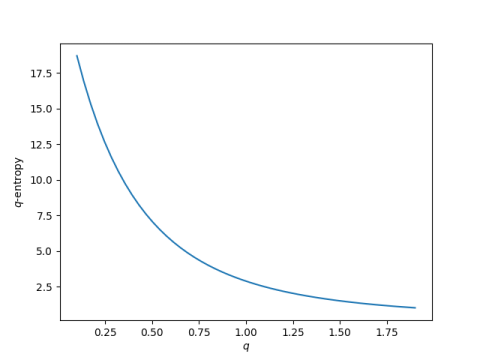The most common way to quantify entropy is Shannon entropy. That’s what people usually mean when they say “entropy” without further qualifications. A while back I wrote about Renyi entropy as a generalization of Shannon entropy. This time I’ll explore a different generalization called q-log entropy, a.k.a. Tsallis entropy.
The definition of Shannon entropy includes the logarithms of probabilities. If we replace these logarithms with a generalization of logarithms, we have a generalization of Shannon entropy.
q-logarithms
The generalization of logarithm we want to look at for this post is the q-logarithm. The natural logarithm is given by
and we can generalize this to the q-logarithm by defining
And so ln1 = ln.
q-logarithm entropy
We can define q-log entropy (a.k.a. Tsallis entropy) by replacing natural log with q-log. However we run into a minor issue.
Shannon entropy (in nats, see [1]) can be defined as either
or
These are equivalent because
However
unless q = 1.
On the other hand, it’s easy to show that
And so we could use either lnq(1/p) or -lnq(p) in our definition of q-log entropy.
The two definitions are not equivalent unless q = 1, but they are related by
Example
To see q-log entropy in action, we’ll plot the entropy of the English alphabet as q varies.

This plot was made using English letter frequencies from here and the following Python code.
def lnq(x, q):
if q == 1:
return np.log(x)
t = 1 - q
return (x**t - 1) / t
def shannon_entropy(ps, base=2):
s = sum(p*np.log(1/p) for p in ps)
return s/np.log(base)
def qlog_entropy(ps, q):
return sum(p*lnq(1/p, q) for p in ps)
The Shannon entropy of the English alphabet is 2.8866 nats [2]. The q-log entropy is greater than that for q less than 1, and smaller than that for q greater than 1.
Related posts
- Solving for probability given entropy
- How fast were ancient languages spoken?
- Bits of information in a zip code
[1] Shannon entropy is usually defined in terms of logarithms base 2, i.e. entropy is usually measured in bits. If we change the base of the logarithm, we only multiply the result by a constant. So we can define Shannon entropy using natural logarithms, resulting in entropy measured in “nats.” More on bits, dits, and nats here.
[2] Or 4.1645 bits. See [1] above for the difference between bits and nats.

There don’t appear to be many applications of Renyi or Tsallis entropy, compared to Shannon entropy, which is a shame because they seem to be more interesting:
http://shape-of-code.coding-guidelines.com/2017/11/15/a-la-carte-entropy/
My theory is that Shannon entropy is the fall-back topic for researchers to wave their arms about when they cannot think of anything else to say:
http://shape-of-code.coding-guidelines.com/2015/04/04/entropy-software-researchers-go-to-topic-when-they-have-no-idea-what-else-to-talk-about/
I work with Renyi entropy sometimes, but I haven’t had a use for q-log entropy yet.
Alright, but why? I guess it’s kind of like averaging using a different norm, and altering the influence we give to the distribution’s tails, but I don’t have a clue when you would want to do that.